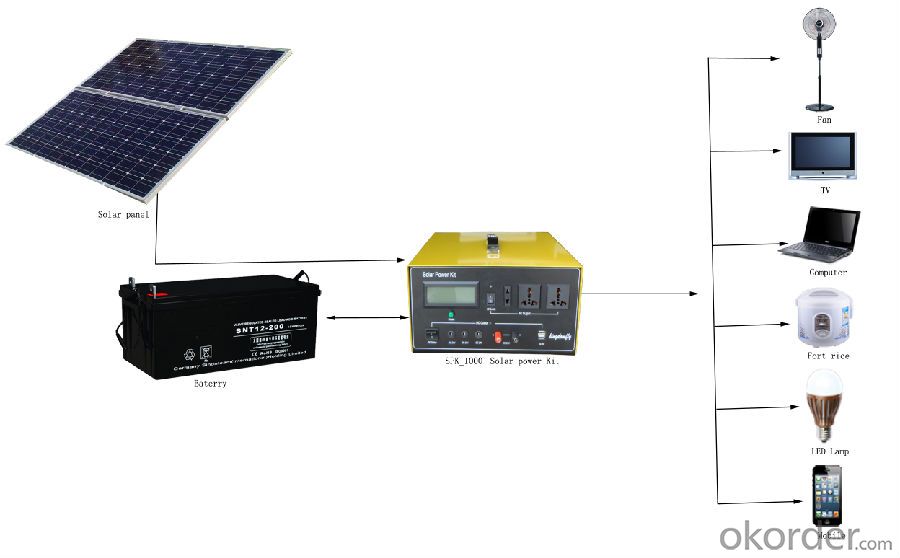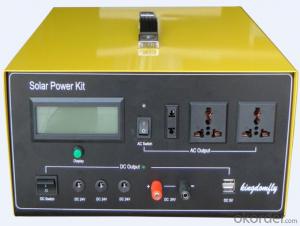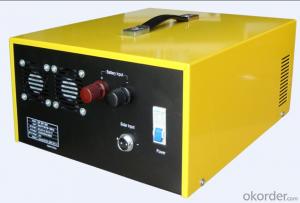Solar Power System for Home Hot Selling SPK_1000
- Loading Port:
- China main port
- Payment Terms:
- TT OR LC
- Min Order Qty:
- 3 pc
- Supply Capability:
- 10000 pc/month
OKorder Service Pledge
OKorder Financial Service
You Might Also Like
Main Information
KDF SPK_1000 This product is high performance,family used portable solar power system,which can receive energy and store it in battery outside connected to SPK by solar energy on sunny day,and supplies electric power for varies appliances such as electric fan,lighting lamps, television, portable computer etc.It can supply power for both DC and AC electric application .It’s very helpful and useful for home electric supply.

Features:
◆ Battery puts outside connected to the SPK for user to choose battery in recommended range, and easily to exchange battery.
◆ Both DC and AC output
◆ Solar Feedback Circuit Protection
◆ Output Short-circuit Protection
◆ Solar「+」「-」anti-access protection
◆ Output「+」「-」anti-access protection
◆ Over Charged Protection
◆ Over Discharged Protection
◆ Over Load Protection
◆ Over-Temperature Protection
Technical parameters
Specification | Value/Material | |
Item No. KDF | SPK_1000 | |
Solar Recommended | Specification | Poly silicon |
Working Voltage/Power | 36V/80W~500W | |
Battery Recommended | Rated Voltage/Capacity | 24V50AH~200AH |
Cycle Number | 80% Deep Cycle Number:500 70% Cycle Number:800 | |
Working Temperature | Short Period(one Month):-20~50℃Long Period(Six Months):-10~45℃ | |
Charging Controller | Operating Voltage | 24V |
Input Voltage | 34.6V~42V | |
Input current | MAX:20A | |
Power Consumption | MAX: 15mA | |
Low Voltage Disconnect(LVD) | 21.6V | |
Low Voltage Reconnect(LVR) | 24.6V | |
High Voltage Discharge( HVC) | 29.2V | |
High Voltage Recharge(HVR) | 27.6V | |
Temperature Protection | 60℃ | |
DC Output | DC output & Application | USB 5V2A |
DC output & Application | DC 24V | |
AC Output | Output Wave | Modified sine wave |
Input Voltage | 22V~30V | |
Output Voltage | 220V±10% | |
Output Frequency | 60Hz±2Hz/50Hz±2Hz | |
Rated Output Power | 1000W | |
Maximum VA | 2000VA | |
Maximum Efficiency | 88% | |
Temperature | 0-40℃ | |
Over Temperature | 60℃~70℃ | |
Low Voltage Alarm | 22V | |
Low Voltage Shut off | 21V | |
High Voltage Shut off | 30V | |
Package | Set size | 350*449*227mm |
Set N·W | 7.2kg | |
Set N·W | 5.2kg | |
LCD_Display

No. | Name | Function |
1 | Battery Icon | To show the Volume of the Battery |
2 | Date of % | To show the percent of the Battery |
3 | Charging Icon | To show the charging condition |
4 | Current | To show the value of charge current |
5 | Temperature Icon | Temperature Alarm |
6 | Date of Voltage | To Show the Value of DC output voltage |
7 | Date of Voltage | To Show the Value of AC output voltage |
8 | AC Icon | AC output |
9 | DC Icon | DC output |
- Q:What is the role of solar trackers in maximizing energy production?
- Solar trackers play a crucial role in maximizing energy production by optimizing the positioning of solar panels to capture the maximum amount of sunlight throughout the day. These devices automatically adjust the angle and orientation of the solar panels to track the movement of the sun, ensuring that they are always aligned at the optimal angle to receive the most sunlight. By continuously monitoring the sun's position and adjusting the panels accordingly, solar trackers significantly enhance the efficiency and energy output of solar energy systems. The main advantage of solar trackers is their ability to increase the overall energy yield of solar installations by up to 25-35% compared to fixed-tilt systems. As the sun moves across the sky, solar trackers follow its path, allowing the panels to capture sunlight from dawn to dusk, maximizing the duration of exposure to direct sunlight. This extended exposure increases the total electricity generation from the panels, making solar trackers especially beneficial in regions with varying weather patterns, seasonal changes, or areas with limited daily sunshine hours. By continuously adapting to the sun's movement, solar trackers also minimize the impact of shading. Shadows from nearby objects, such as buildings, trees, or even clouds, can significantly reduce the efficiency of solar panels. However, solar trackers can mitigate the effects of shading by adjusting the panels' positioning to avoid or minimize the shadow's impact. This ensures that the solar panels are consistently exposed to direct sunlight, maximizing the energy production potential of the entire system. Furthermore, solar trackers can contribute to reducing the payback period of solar installations. With their ability to generate more electricity, solar trackers enhance the return on investment by increasing the overall energy production and subsequently reducing the time it takes to recoup the initial costs of the system. By optimizing energy production and improving the economic viability of solar installations, solar trackers are playing a crucial role in accelerating the adoption of renewable energy and transitioning towards a sustainable future.
- Q:How does a solar energy system convert sunlight into electricity?
- A solar energy system converts sunlight into electricity through the use of photovoltaic (PV) cells. These cells are made up of semiconductor materials, such as silicon, that absorb the photons present in sunlight. When the photons strike the PV cells, they knock electrons loose from their atoms, creating an electric current. This current is then captured and harnessed to generate usable electricity, which can power homes, businesses, and other electrical devices.
- Q:How does temperature affect the efficiency of solar panels?
- Temperature affects the efficiency of solar panels by causing a decrease in their overall performance. As the temperature rises, the efficiency of solar panels decreases due to the negative thermal coefficient of their photovoltaic cells. This means that as the temperature increases, the voltage output of the cells decreases, resulting in a reduction in the power generated by the panels.
- Q:How does the installation of solar panels affect the roof's warranty?
- The installation of solar panels typically does not void the roof's warranty. However, it is important to consult with the roofing manufacturer and installer to ensure that the installation process does not breach any warranty conditions.
- Q:Can solar panels be used to power agricultural irrigation systems?
- Yes, solar panels can be used to power agricultural irrigation systems. Solar energy can be converted into electricity, which can then be used to power pumps and other irrigation equipment. This sustainable and renewable energy source offers a cost-effective and environmentally friendly solution for powering irrigation systems in remote and off-grid areas.
- Q:Can solar energy systems be used for powering telecommunications infrastructure?
- Yes, solar energy systems can be used to power telecommunications infrastructure. Solar panels can be installed on rooftops or in open spaces to harness sunlight and convert it into electricity. This renewable energy can then be used to power communication towers, equipment, and other telecommunications infrastructure, providing a sustainable and reliable energy source. Additionally, solar energy systems can be combined with battery storage solutions to ensure uninterrupted power supply even during periods of low sunlight or at night.
- Q:Can a solar energy system be used in areas prone to hurricanes or tornadoes?
- Yes, a solar energy system can be used in areas prone to hurricanes or tornadoes. While it is true that these natural disasters can cause damage to solar panels and other components of the system, proper planning and installation can mitigate the risks. One key consideration is the design and structural integrity of the solar panels themselves. High-quality solar panels are built to withstand strong winds and extreme weather conditions. They are usually tested and certified to meet specific standards, including wind resistance ratings. In areas prone to hurricanes or tornadoes, it is important to install solar panels that are specifically designed to withstand the potential wind speeds and impacts associated with these events. Additionally, proper installation techniques can enhance the resilience of a solar energy system. For example, using reinforced mounting structures, securing panels with additional brackets or fasteners, and ensuring secure connections between panels, inverters, and batteries can help prevent damage caused by strong winds or flying debris. In some cases, homeowners may also choose to invest in solar panel tracking systems that allow the panels to automatically adjust their position to reduce wind resistance during extreme weather events. This feature can help protect the panels and increase their chances of surviving a hurricane or tornado with minimal damage. Furthermore, it is essential to have a backup power storage system in place, such as batteries, to ensure continuous power supply during and after a severe weather event. This backup system can store excess energy generated by the solar panels, allowing the system to operate independently of the grid during power outages caused by hurricanes or tornadoes. Overall, while there are risks associated with using a solar energy system in areas prone to hurricanes or tornadoes, careful planning, proper installation, and the use of resilient components can make it possible to harness solar power even in these challenging environments.
- Q:How often do solar panels need to be cleaned or maintained?
- Solar panels typically require minimal maintenance and cleaning. In most cases, they only need to be cleaned once or twice a year, depending on the location and climate. Regular inspections and light cleaning can help ensure optimal performance and efficiency of solar panels.
- Q:Can a solar energy system be used in conjunction with other renewable energy sources?
- Certainly, a solar energy system can be utilized alongside other renewable energy sources. In fact, the amalgamation of various renewable energy sources is often referred to as a hybrid renewable energy system, which can yield numerous benefits. By integrating solar energy with sources like wind, hydro, or geothermal energy, a hybrid system can provide a more consistent and dependable power supply. This is due to the different energy generation patterns of each source, and combining them can compensate for any fluctuations or limitations in a specific source. For instance, solar energy production peaks during the day, while wind energy remains relatively constant throughout the day and night. The integration of these two sources ensures a continuous power supply. Moreover, the utilization of multiple renewable energy sources can maximize overall energy production and efficiency. Each source possesses its own strengths and weaknesses, and combining them can amplify the total energy output. This is particularly advantageous in scenarios with high energy demand or when one source alone may not suffice to meet energy needs. Furthermore, a hybrid renewable energy system can enhance energy independence and resilience. By diversifying the energy sources, the system becomes less reliant on a single source, reducing vulnerability to disruptions or failures. This is especially crucial in remote or off-grid areas where access to a reliable power supply is essential. In conclusion, a solar energy system can effectively be used together with other renewable energy sources to create a hybrid system. This approach offers various advantages, including enhanced reliability, improved efficiency, and increased energy independence. By combining multiple renewable energy sources, we can capitalize on their unique strengths and establish a more sustainable and resilient energy system.
- Q:Can solar energy systems be used in powering scientific research vessels or marine laboratories?
- Indeed, it is possible to utilize solar energy systems for the purpose of powering scientific research vessels or marine laboratories. Solar energy, being a renewable and sustainable power source, can be harnessed through the utilization of photovoltaic panels or solar thermal collectors. The energy requirements of research vessels and marine laboratories are substantial, given the nature of their operations which involve scientific experiments, data collection, and analysis. These activities usually involve the use of equipment like computers, sensors, and laboratory instruments, which necessitate a continuous and dependable power supply. To address this need, solar energy systems can be installed on said vessels or laboratories, providing a clean and efficient source of electricity. Through the conversion of sunlight into electricity via photovoltaic panels, the various equipment and systems on board can be powered. Moreover, any excess energy produced by the solar panels can be stored in batteries to be utilized during periods of decreased sunlight or at night. The utilization of solar energy in these marine environments presents numerous advantages. Firstly, it diminishes reliance on fossil fuels and diminishes the carbon footprint associated with conventional methods of power generation. This is particularly vital in the context of scientific research as it aligns with the principles of environmental sustainability and conservation. Secondly, solar energy systems offer a reliable and autonomous power source. Research vessels and marine laboratories often operate in remote or secluded locations where access to traditional power grids may be limited or non-existent. By harnessing solar energy, these vessels and facilities can generate their own electricity, enabling them to continue their research activities without depending on external power sources. Lastly, solar energy systems necessitate minimal maintenance and have a lengthy lifespan. Once installed, they require minimal upkeep and are capable of withstanding the harsh marine environment. This makes them highly suitable for use in research vessels or marine laboratories, where downtime and maintenance issues can be disruptive to ongoing scientific projects. In conclusion, there is no doubt that solar energy systems can be effectively employed to power scientific research vessels or marine laboratories. They offer a sustainable, reliable, and autonomous source of electricity, thereby reducing the carbon footprint and ensuring uninterrupted research activities, even in remote locations.
1. Manufacturer Overview |
|
|---|---|
| Location | |
| Year Established | |
| Annual Output Value | |
| Main Markets | |
| Company Certifications | |
2. Manufacturer Certificates |
|
|---|---|
| a) Certification Name | |
| Range | |
| Reference | |
| Validity Period | |
3. Manufacturer Capability |
|
|---|---|
| a)Trade Capacity | |
| Nearest Port | |
| Export Percentage | |
| No.of Employees in Trade Department | |
| Language Spoken: | |
| b)Factory Information | |
| Factory Size: | |
| No. of Production Lines | |
| Contract Manufacturing | |
| Product Price Range | |
Send your message to us
Solar Power System for Home Hot Selling SPK_1000
- Loading Port:
- China main port
- Payment Terms:
- TT OR LC
- Min Order Qty:
- 3 pc
- Supply Capability:
- 10000 pc/month
OKorder Service Pledge
OKorder Financial Service
Similar products
New products
Hot products
Related keywords






























